Impact of Human Actions on Endangered Species Research Paper 2022
VerifiedAdded on 2022/09/23
|9
|2370
|18
AI Summary
Contribute Materials
Your contribution can guide someone’s learning journey. Share your
documents today.
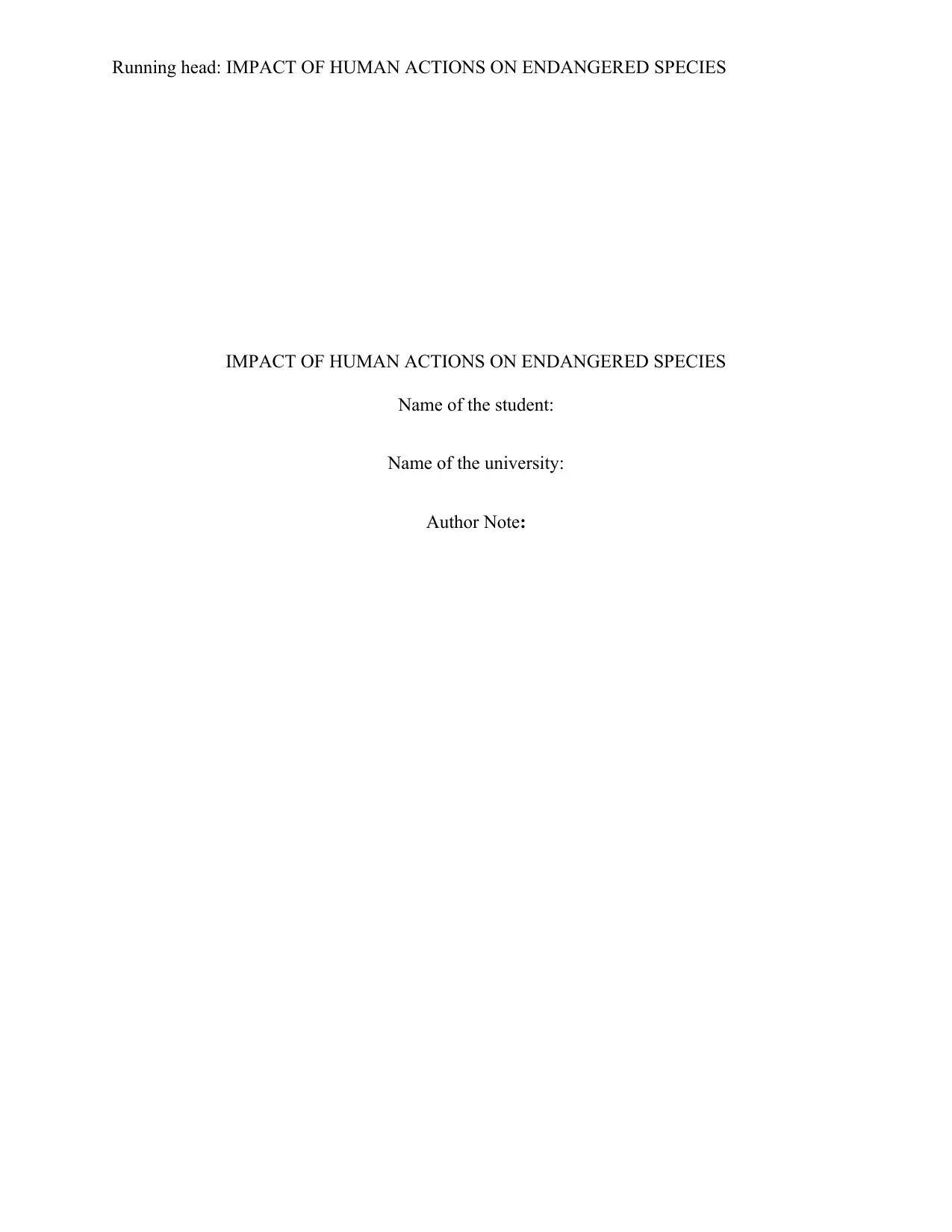
Running head: IMPACT OF HUMAN ACTIONS ON ENDANGERED SPECIES
IMPACT OF HUMAN ACTIONS ON ENDANGERED SPECIES
Name of the student:
Name of the university:
Author Note:
IMPACT OF HUMAN ACTIONS ON ENDANGERED SPECIES
Name of the student:
Name of the university:
Author Note:
Secure Best Marks with AI Grader
Need help grading? Try our AI Grader for instant feedback on your assignments.
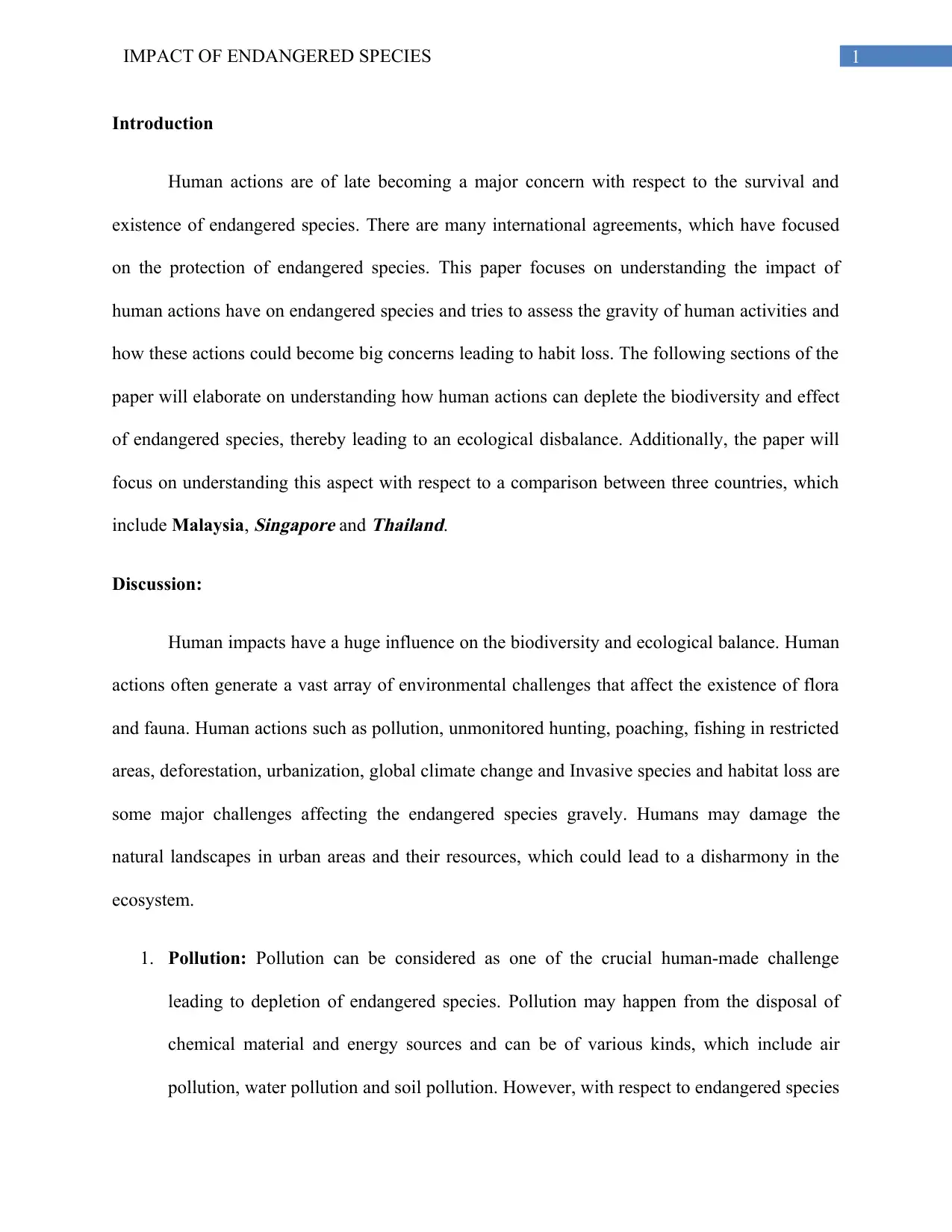
1IMPACT OF ENDANGERED SPECIES
Introduction
Human actions are of late becoming a major concern with respect to the survival and
existence of endangered species. There are many international agreements, which have focused
on the protection of endangered species. This paper focuses on understanding the impact of
human actions have on endangered species and tries to assess the gravity of human activities and
how these actions could become big concerns leading to habit loss. The following sections of the
paper will elaborate on understanding how human actions can deplete the biodiversity and effect
of endangered species, thereby leading to an ecological disbalance. Additionally, the paper will
focus on understanding this aspect with respect to a comparison between three countries, which
include Malaysia,
Singapore and
Thailand.
Discussion:
Human impacts have a huge influence on the biodiversity and ecological balance. Human
actions often generate a vast array of environmental challenges that affect the existence of flora
and fauna. Human actions such as pollution, unmonitored hunting, poaching, fishing in restricted
areas, deforestation, urbanization, global climate change and Invasive species and habitat loss are
some major challenges affecting the endangered species gravely. Humans may damage the
natural landscapes in urban areas and their resources, which could lead to a disharmony in the
ecosystem.
1. Pollution: Pollution can be considered as one of the crucial human-made challenge
leading to depletion of endangered species. Pollution may happen from the disposal of
chemical material and energy sources and can be of various kinds, which include air
pollution, water pollution and soil pollution. However, with respect to endangered species
Introduction
Human actions are of late becoming a major concern with respect to the survival and
existence of endangered species. There are many international agreements, which have focused
on the protection of endangered species. This paper focuses on understanding the impact of
human actions have on endangered species and tries to assess the gravity of human activities and
how these actions could become big concerns leading to habit loss. The following sections of the
paper will elaborate on understanding how human actions can deplete the biodiversity and effect
of endangered species, thereby leading to an ecological disbalance. Additionally, the paper will
focus on understanding this aspect with respect to a comparison between three countries, which
include Malaysia,
Singapore and
Thailand.
Discussion:
Human impacts have a huge influence on the biodiversity and ecological balance. Human
actions often generate a vast array of environmental challenges that affect the existence of flora
and fauna. Human actions such as pollution, unmonitored hunting, poaching, fishing in restricted
areas, deforestation, urbanization, global climate change and Invasive species and habitat loss are
some major challenges affecting the endangered species gravely. Humans may damage the
natural landscapes in urban areas and their resources, which could lead to a disharmony in the
ecosystem.
1. Pollution: Pollution can be considered as one of the crucial human-made challenge
leading to depletion of endangered species. Pollution may happen from the disposal of
chemical material and energy sources and can be of various kinds, which include air
pollution, water pollution and soil pollution. However, with respect to endangered species
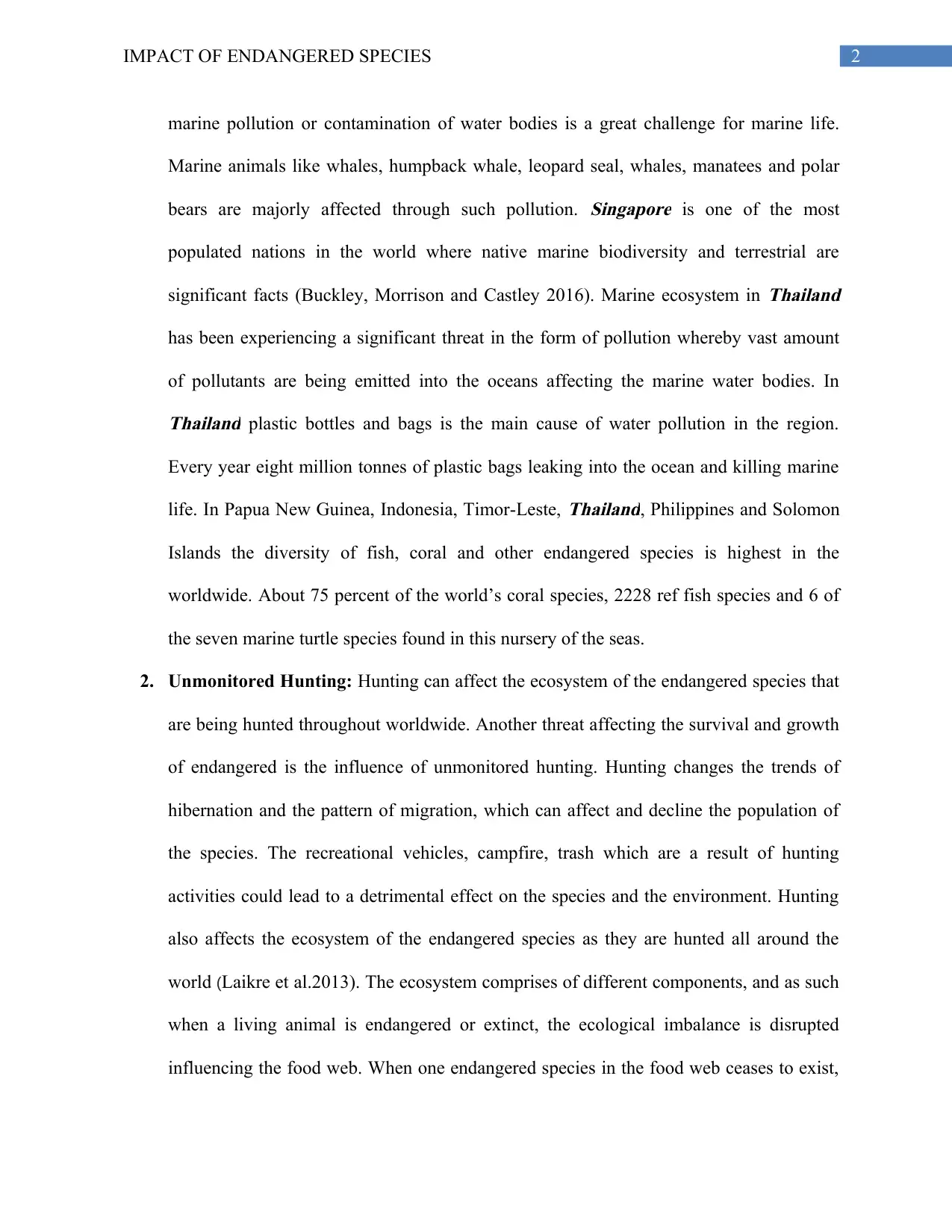
2IMPACT OF ENDANGERED SPECIES
marine pollution or contamination of water bodies is a great challenge for marine life.
Marine animals like whales, humpback whale, leopard seal, whales, manatees and polar
bears are majorly affected through such pollution.
Singapore is one of the most
populated nations in the world where native marine biodiversity and terrestrial are
significant facts (Buckley, Morrison and Castley 2016). Marine ecosystem in
Thailand
has been experiencing a significant threat in the form of pollution whereby vast amount
of pollutants are being emitted into the oceans affecting the marine water bodies. InThailand plastic bottles and bags is the main cause of water pollution in the region.
Every year eight million tonnes of plastic bags leaking into the ocean and killing marine
life. In Papua New Guinea, Indonesia, Timor-Leste,
Thailand, Philippines and Solomon
Islands the diversity of fish, coral and other endangered species is highest in the
worldwide. About 75 percent of the world’s coral species, 2228 ref fish species and 6 of
the seven marine turtle species found in this nursery of the seas.
2. Unmonitored Hunting: Hunting can affect the ecosystem of the endangered species that
are being hunted throughout worldwide. Another threat affecting the survival and growth
of endangered is the influence of unmonitored hunting. Hunting changes the trends of
hibernation and the pattern of migration, which can affect and decline the population of
the species. The recreational vehicles, campfire, trash which are a result of hunting
activities could lead to a detrimental effect on the species and the environment. Hunting
also affects the ecosystem of the endangered species as they are hunted all around the
world (Laikre et al.2013). The ecosystem comprises of different components, and as such
when a living animal is endangered or extinct, the ecological imbalance is disrupted
influencing the food web. When one endangered species in the food web ceases to exist,
marine pollution or contamination of water bodies is a great challenge for marine life.
Marine animals like whales, humpback whale, leopard seal, whales, manatees and polar
bears are majorly affected through such pollution.
Singapore is one of the most
populated nations in the world where native marine biodiversity and terrestrial are
significant facts (Buckley, Morrison and Castley 2016). Marine ecosystem in
Thailand
has been experiencing a significant threat in the form of pollution whereby vast amount
of pollutants are being emitted into the oceans affecting the marine water bodies. InThailand plastic bottles and bags is the main cause of water pollution in the region.
Every year eight million tonnes of plastic bags leaking into the ocean and killing marine
life. In Papua New Guinea, Indonesia, Timor-Leste,
Thailand, Philippines and Solomon
Islands the diversity of fish, coral and other endangered species is highest in the
worldwide. About 75 percent of the world’s coral species, 2228 ref fish species and 6 of
the seven marine turtle species found in this nursery of the seas.
2. Unmonitored Hunting: Hunting can affect the ecosystem of the endangered species that
are being hunted throughout worldwide. Another threat affecting the survival and growth
of endangered is the influence of unmonitored hunting. Hunting changes the trends of
hibernation and the pattern of migration, which can affect and decline the population of
the species. The recreational vehicles, campfire, trash which are a result of hunting
activities could lead to a detrimental effect on the species and the environment. Hunting
also affects the ecosystem of the endangered species as they are hunted all around the
world (Laikre et al.2013). The ecosystem comprises of different components, and as such
when a living animal is endangered or extinct, the ecological imbalance is disrupted
influencing the food web. When one endangered species in the food web ceases to exist,
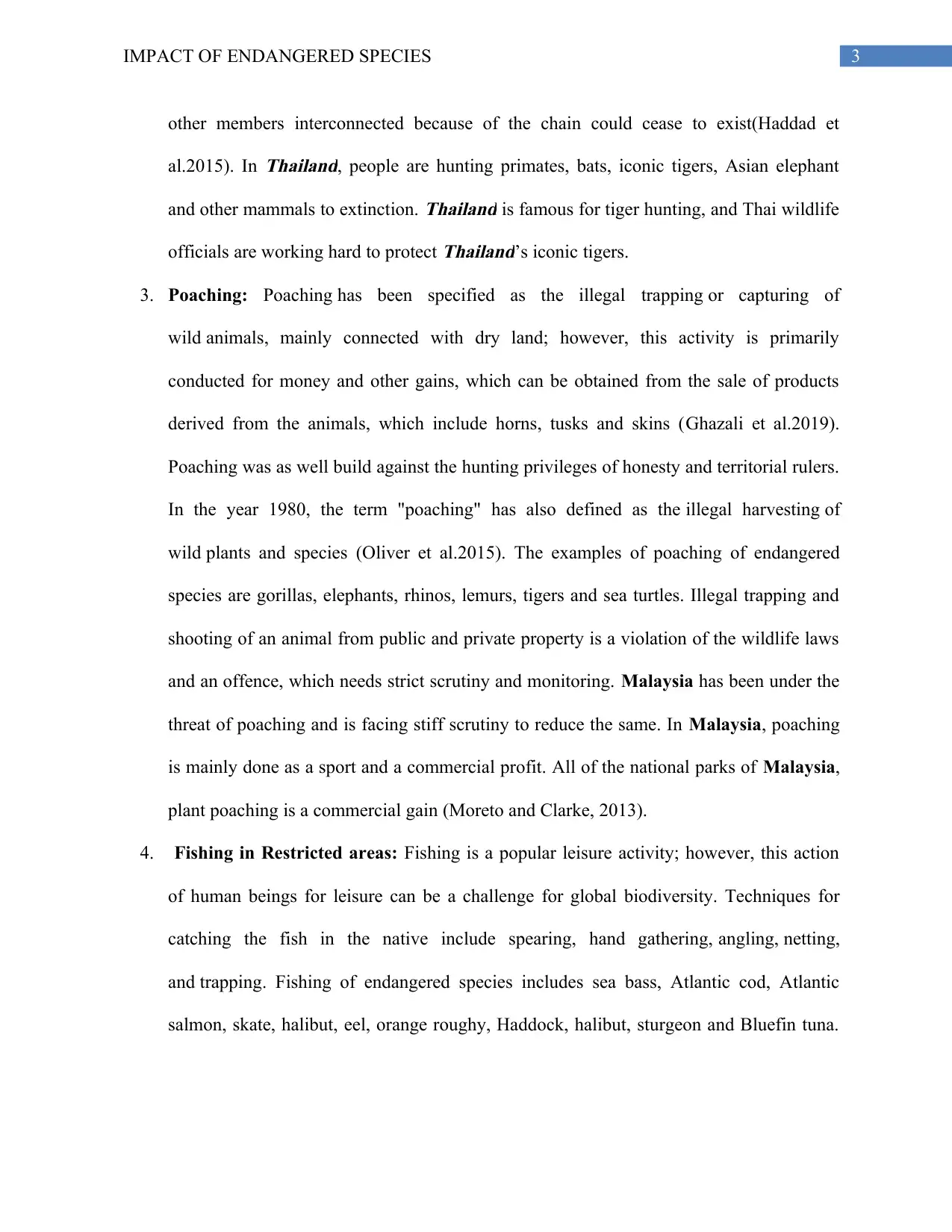
3IMPACT OF ENDANGERED SPECIES
other members interconnected because of the chain could cease to exist(Haddad et
al.2015). In
Thailand, people are hunting primates, bats, iconic tigers, Asian elephant
and other mammals to extinction.
Thailand is famous for tiger hunting, and Thai wildlife
officials are working hard to protect
Thailand’s iconic tigers.
3. Poaching: Poaching has been specified as the illegal trapping or capturing of
wild animals, mainly connected with dry land; however, this activity is primarily
conducted for money and other gains, which can be obtained from the sale of products
derived from the animals, which include horns, tusks and skins (Ghazali et al.2019).
Poaching was as well build against the hunting privileges of honesty and territorial rulers.
In the year 1980, the term "poaching" has also defined as the illegal harvesting of
wild plants and species (Oliver et al.2015). The examples of poaching of endangered
species are gorillas, elephants, rhinos, lemurs, tigers and sea turtles. Illegal trapping and
shooting of an animal from public and private property is a violation of the wildlife laws
and an offence, which needs strict scrutiny and monitoring. Malaysia has been under the
threat of poaching and is facing stiff scrutiny to reduce the same. In Malaysia, poaching
is mainly done as a sport and a commercial profit. All of the national parks of Malaysia,
plant poaching is a commercial gain (Moreto and Clarke, 2013).
4. Fishing in Restricted areas: Fishing is a popular leisure activity; however, this action
of human beings for leisure can be a challenge for global biodiversity. Techniques for
catching the fish in the native include spearing, hand gathering, angling, netting,
and trapping. Fishing of endangered species includes sea bass, Atlantic cod, Atlantic
salmon, skate, halibut, eel, orange roughy, Haddock, halibut, sturgeon and Bluefin tuna.
other members interconnected because of the chain could cease to exist(Haddad et
al.2015). In
Thailand, people are hunting primates, bats, iconic tigers, Asian elephant
and other mammals to extinction.
Thailand is famous for tiger hunting, and Thai wildlife
officials are working hard to protect
Thailand’s iconic tigers.
3. Poaching: Poaching has been specified as the illegal trapping or capturing of
wild animals, mainly connected with dry land; however, this activity is primarily
conducted for money and other gains, which can be obtained from the sale of products
derived from the animals, which include horns, tusks and skins (Ghazali et al.2019).
Poaching was as well build against the hunting privileges of honesty and territorial rulers.
In the year 1980, the term "poaching" has also defined as the illegal harvesting of
wild plants and species (Oliver et al.2015). The examples of poaching of endangered
species are gorillas, elephants, rhinos, lemurs, tigers and sea turtles. Illegal trapping and
shooting of an animal from public and private property is a violation of the wildlife laws
and an offence, which needs strict scrutiny and monitoring. Malaysia has been under the
threat of poaching and is facing stiff scrutiny to reduce the same. In Malaysia, poaching
is mainly done as a sport and a commercial profit. All of the national parks of Malaysia,
plant poaching is a commercial gain (Moreto and Clarke, 2013).
4. Fishing in Restricted areas: Fishing is a popular leisure activity; however, this action
of human beings for leisure can be a challenge for global biodiversity. Techniques for
catching the fish in the native include spearing, hand gathering, angling, netting,
and trapping. Fishing of endangered species includes sea bass, Atlantic cod, Atlantic
salmon, skate, halibut, eel, orange roughy, Haddock, halibut, sturgeon and Bluefin tuna.
Secure Best Marks with AI Grader
Need help grading? Try our AI Grader for instant feedback on your assignments.
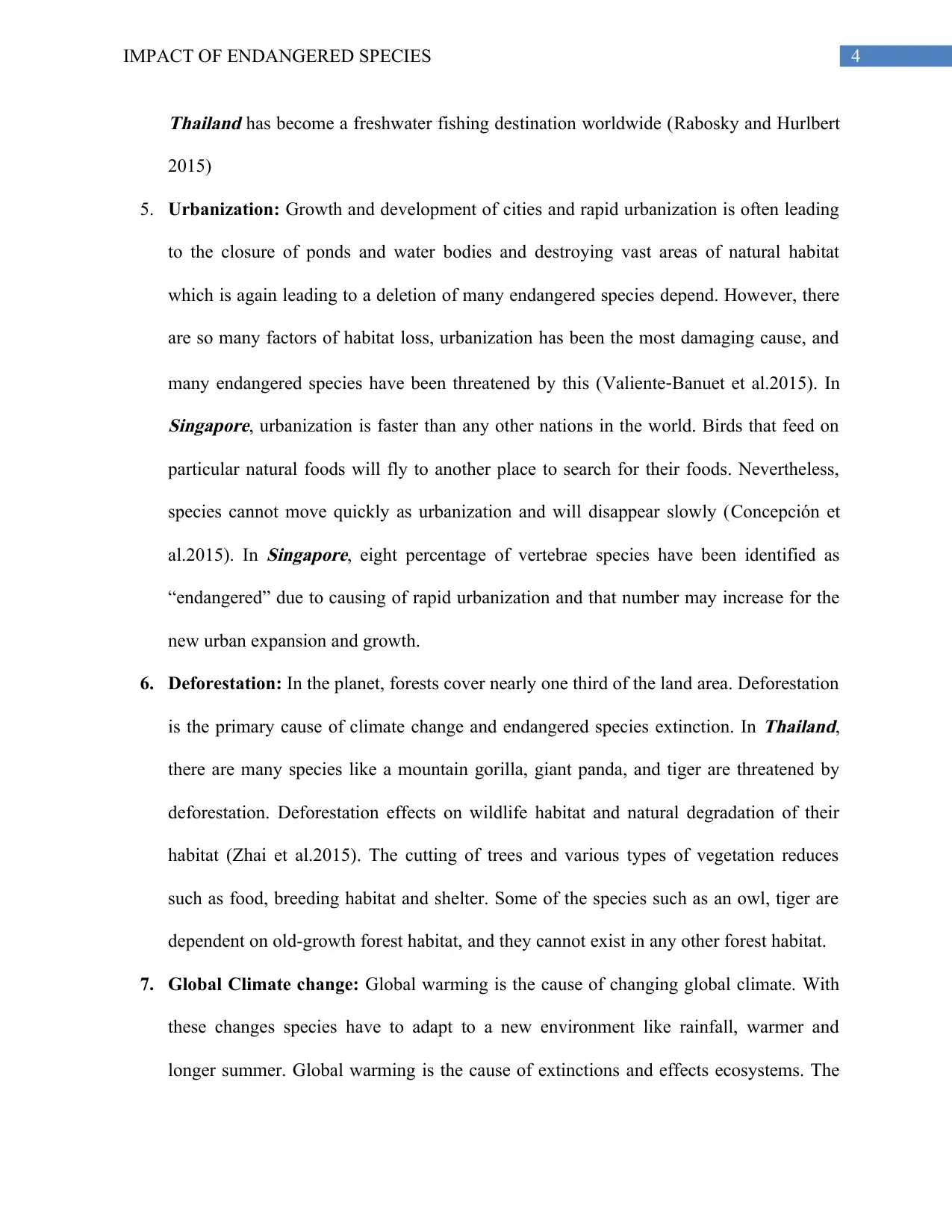
4IMPACT OF ENDANGERED SPECIES
Thailand has become a freshwater fishing destination worldwide (Rabosky and Hurlbert
2015)
5. Urbanization: Growth and development of cities and rapid urbanization is often leading
to the closure of ponds and water bodies and destroying vast areas of natural habitat
which is again leading to a deletion of many endangered species depend. However, there
are so many factors of habitat loss, urbanization has been the most damaging cause, and
many endangered species have been threatened by this (Valiente‐Banuet et al.2015). InSingapore, urbanization is faster than any other nations in the world. Birds that feed on
particular natural foods will fly to another place to search for their foods. Nevertheless,
species cannot move quickly as urbanization and will disappear slowly (Concepción et
al.2015). In
Singapore, eight percentage of vertebrae species have been identified as
“endangered” due to causing of rapid urbanization and that number may increase for the
new urban expansion and growth.
6. Deforestation: In the planet, forests cover nearly one third of the land area. Deforestation
is the primary cause of climate change and endangered species extinction. In
Thailand,
there are many species like a mountain gorilla, giant panda, and tiger are threatened by
deforestation. Deforestation effects on wildlife habitat and natural degradation of their
habitat (Zhai et al.2015). The cutting of trees and various types of vegetation reduces
such as food, breeding habitat and shelter. Some of the species such as an owl, tiger are
dependent on old-growth forest habitat, and they cannot exist in any other forest habitat.
7. Global Climate change: Global warming is the cause of changing global climate. With
these changes species have to adapt to a new environment like rainfall, warmer and
longer summer. Global warming is the cause of extinctions and effects ecosystems. The
Thailand has become a freshwater fishing destination worldwide (Rabosky and Hurlbert
2015)
5. Urbanization: Growth and development of cities and rapid urbanization is often leading
to the closure of ponds and water bodies and destroying vast areas of natural habitat
which is again leading to a deletion of many endangered species depend. However, there
are so many factors of habitat loss, urbanization has been the most damaging cause, and
many endangered species have been threatened by this (Valiente‐Banuet et al.2015). InSingapore, urbanization is faster than any other nations in the world. Birds that feed on
particular natural foods will fly to another place to search for their foods. Nevertheless,
species cannot move quickly as urbanization and will disappear slowly (Concepción et
al.2015). In
Singapore, eight percentage of vertebrae species have been identified as
“endangered” due to causing of rapid urbanization and that number may increase for the
new urban expansion and growth.
6. Deforestation: In the planet, forests cover nearly one third of the land area. Deforestation
is the primary cause of climate change and endangered species extinction. In
Thailand,
there are many species like a mountain gorilla, giant panda, and tiger are threatened by
deforestation. Deforestation effects on wildlife habitat and natural degradation of their
habitat (Zhai et al.2015). The cutting of trees and various types of vegetation reduces
such as food, breeding habitat and shelter. Some of the species such as an owl, tiger are
dependent on old-growth forest habitat, and they cannot exist in any other forest habitat.
7. Global Climate change: Global warming is the cause of changing global climate. With
these changes species have to adapt to a new environment like rainfall, warmer and
longer summer. Global warming is the cause of extinctions and effects ecosystems. The
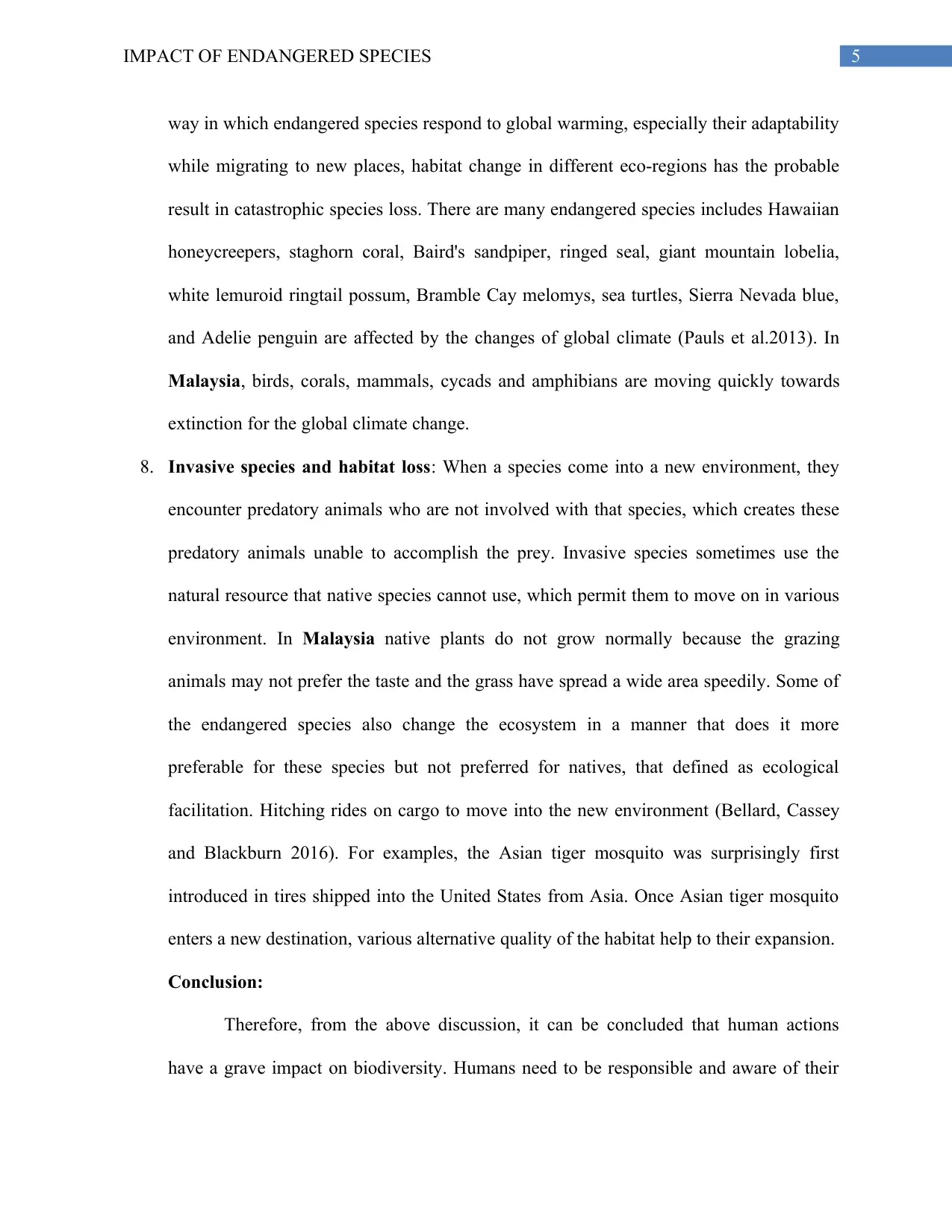
5IMPACT OF ENDANGERED SPECIES
way in which endangered species respond to global warming, especially their adaptability
while migrating to new places, habitat change in different eco-regions has the probable
result in catastrophic species loss. There are many endangered species includes Hawaiian
honeycreepers, staghorn coral, Baird's sandpiper, ringed seal, giant mountain lobelia,
white lemuroid ringtail possum, Bramble Cay melomys, sea turtles, Sierra Nevada blue,
and Adelie penguin are affected by the changes of global climate (Pauls et al.2013). In
Malaysia, birds, corals, mammals, cycads and amphibians are moving quickly towards
extinction for the global climate change.
8. Invasive species and habitat loss: When a species come into a new environment, they
encounter predatory animals who are not involved with that species, which creates these
predatory animals unable to accomplish the prey. Invasive species sometimes use the
natural resource that native species cannot use, which permit them to move on in various
environment. In Malaysia native plants do not grow normally because the grazing
animals may not prefer the taste and the grass have spread a wide area speedily. Some of
the endangered species also change the ecosystem in a manner that does it more
preferable for these species but not preferred for natives, that defined as ecological
facilitation. Hitching rides on cargo to move into the new environment (Bellard, Cassey
and Blackburn 2016). For examples, the Asian tiger mosquito was surprisingly first
introduced in tires shipped into the United States from Asia. Once Asian tiger mosquito
enters a new destination, various alternative quality of the habitat help to their expansion.
Conclusion:
Therefore, from the above discussion, it can be concluded that human actions
have a grave impact on biodiversity. Humans need to be responsible and aware of their
way in which endangered species respond to global warming, especially their adaptability
while migrating to new places, habitat change in different eco-regions has the probable
result in catastrophic species loss. There are many endangered species includes Hawaiian
honeycreepers, staghorn coral, Baird's sandpiper, ringed seal, giant mountain lobelia,
white lemuroid ringtail possum, Bramble Cay melomys, sea turtles, Sierra Nevada blue,
and Adelie penguin are affected by the changes of global climate (Pauls et al.2013). In
Malaysia, birds, corals, mammals, cycads and amphibians are moving quickly towards
extinction for the global climate change.
8. Invasive species and habitat loss: When a species come into a new environment, they
encounter predatory animals who are not involved with that species, which creates these
predatory animals unable to accomplish the prey. Invasive species sometimes use the
natural resource that native species cannot use, which permit them to move on in various
environment. In Malaysia native plants do not grow normally because the grazing
animals may not prefer the taste and the grass have spread a wide area speedily. Some of
the endangered species also change the ecosystem in a manner that does it more
preferable for these species but not preferred for natives, that defined as ecological
facilitation. Hitching rides on cargo to move into the new environment (Bellard, Cassey
and Blackburn 2016). For examples, the Asian tiger mosquito was surprisingly first
introduced in tires shipped into the United States from Asia. Once Asian tiger mosquito
enters a new destination, various alternative quality of the habitat help to their expansion.
Conclusion:
Therefore, from the above discussion, it can be concluded that human actions
have a grave impact on biodiversity. Humans need to be responsible and aware of their
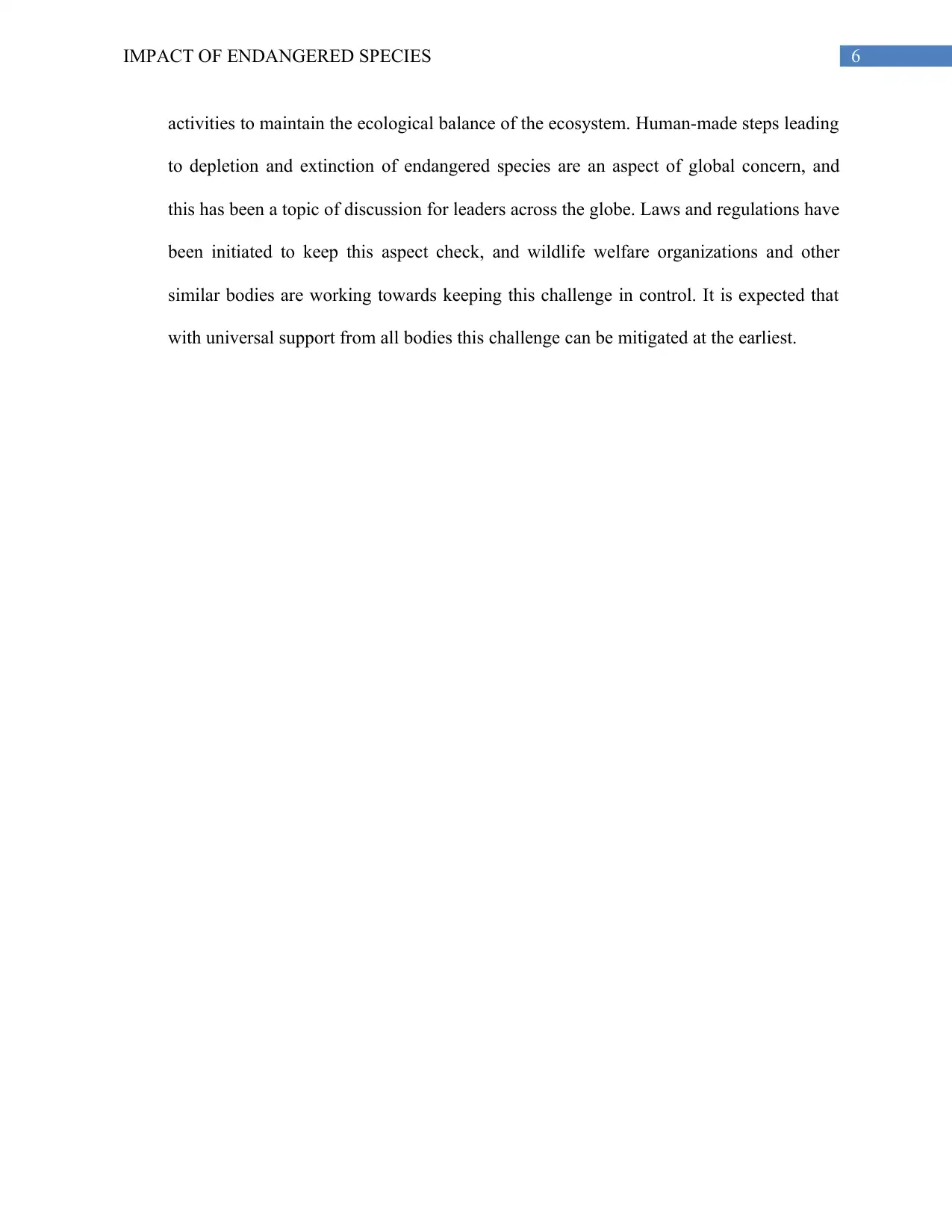
6IMPACT OF ENDANGERED SPECIES
activities to maintain the ecological balance of the ecosystem. Human-made steps leading
to depletion and extinction of endangered species are an aspect of global concern, and
this has been a topic of discussion for leaders across the globe. Laws and regulations have
been initiated to keep this aspect check, and wildlife welfare organizations and other
similar bodies are working towards keeping this challenge in control. It is expected that
with universal support from all bodies this challenge can be mitigated at the earliest.
activities to maintain the ecological balance of the ecosystem. Human-made steps leading
to depletion and extinction of endangered species are an aspect of global concern, and
this has been a topic of discussion for leaders across the globe. Laws and regulations have
been initiated to keep this aspect check, and wildlife welfare organizations and other
similar bodies are working towards keeping this challenge in control. It is expected that
with universal support from all bodies this challenge can be mitigated at the earliest.
Paraphrase This Document
Need a fresh take? Get an instant paraphrase of this document with our AI Paraphraser

7IMPACT OF ENDANGERED SPECIES
References:
Bellard, C., Cassey, P. and Blackburn, T.M., 2016. Alien species as a driver of recent
extinctions. Biology letters, 12(2), p.20150623.
Buckley, R.C., Morrison, C. and Castley, J.G., 2016. Net effects of ecotourism on threatened
species survival. PloS one, 11(2), p.e0147988.
Concepción, E.D., Moretti, M., Altermatt, F., Nobis, M.P. and Obrist, M.K., 2015. Impacts of
urbanisation on biodiversity: the role of species mobility, degree of specialisation and spatial
scale. Oikos, 124(12), pp.1571-1582.
Ghazali, A.N., Meisery, A.A.H.A., Adam, L., Hasnan, M.H.S., Yazi, M.F., Patah, P.A., Rozi,
M.S.F.M., Rasid, A.F.A. and Tan, C.C., 2019. Wildlife monitoring at Labis Timur Ecological
Corridor (CFS2: PL1) in Johor, Malaysia. Journal of Wildlife and Parks, 34, p.2.
Haddad, N.M., Brudvig, L.A., Clobert, J., Davies, K.F., Gonzalez, A., Holt, R.D., Lovejoy, T.E.,
Sexton, J.O., Austin, M.P., Collins, C.D. and Cook, W.M., 2015. Habitat fragmentation and its
lasting impact on Earth’s ecosystems. Science advances, 1(2), p.e1500052.
Laikre, L., Jansson, M., Allendorf, F.W., Jakobsson, S. and Ryman, N., 2013. Hunting effects on
favourable conservation status of highly inbred Swedish wolves. Conservation biology, 27(2),
pp.248-253
Moreto, W.D. and Clarke, R.V., 2013. 11 Script analysis of the transnational illegal market in
endangered species. Cognition and crime: Offender decision making and script analyses, p.209.
References:
Bellard, C., Cassey, P. and Blackburn, T.M., 2016. Alien species as a driver of recent
extinctions. Biology letters, 12(2), p.20150623.
Buckley, R.C., Morrison, C. and Castley, J.G., 2016. Net effects of ecotourism on threatened
species survival. PloS one, 11(2), p.e0147988.
Concepción, E.D., Moretti, M., Altermatt, F., Nobis, M.P. and Obrist, M.K., 2015. Impacts of
urbanisation on biodiversity: the role of species mobility, degree of specialisation and spatial
scale. Oikos, 124(12), pp.1571-1582.
Ghazali, A.N., Meisery, A.A.H.A., Adam, L., Hasnan, M.H.S., Yazi, M.F., Patah, P.A., Rozi,
M.S.F.M., Rasid, A.F.A. and Tan, C.C., 2019. Wildlife monitoring at Labis Timur Ecological
Corridor (CFS2: PL1) in Johor, Malaysia. Journal of Wildlife and Parks, 34, p.2.
Haddad, N.M., Brudvig, L.A., Clobert, J., Davies, K.F., Gonzalez, A., Holt, R.D., Lovejoy, T.E.,
Sexton, J.O., Austin, M.P., Collins, C.D. and Cook, W.M., 2015. Habitat fragmentation and its
lasting impact on Earth’s ecosystems. Science advances, 1(2), p.e1500052.
Laikre, L., Jansson, M., Allendorf, F.W., Jakobsson, S. and Ryman, N., 2013. Hunting effects on
favourable conservation status of highly inbred Swedish wolves. Conservation biology, 27(2),
pp.248-253
Moreto, W.D. and Clarke, R.V., 2013. 11 Script analysis of the transnational illegal market in
endangered species. Cognition and crime: Offender decision making and script analyses, p.209.

8IMPACT OF ENDANGERED SPECIES
Oliver, T.H., Heard, M.S., Isaac, N.J., Roy, D.B., Procter, D., Eigenbrod, F., Freckleton, R.,
Hector, A., Orme, C.D.L., Petchey, O.L. and Proença, V., 2015. Biodiversity and resilience of
ecosystem functions. Trends in ecology & evolution, 30(11), pp.673-684.
Pauls, S.U., Nowak, C., Bálint, M. and Pfenninger, M., 2013. The impact of global climate
change on genetic diversity within populations and species. Molecular ecology, 22(4), pp.925-
946.
Rabosky, D.L. and Hurlbert, A.H., 2015. Species richness at continental scales is dominated by
ecological limits. The American Naturalist, 185(5), pp.572-583.
Valiente‐Banuet, A., Aizen, M.A., Alcántara, J.M., Arroyo, J., Cocucci, A., Galetti, M., García,
M.B., García, D., Gómez, J.M., Jordano, P. and Medel, R., 2015. Beyond species loss: the
extinction of ecological interactions in a changing world. Functional Ecology, 29(3), pp.299-307.
Zhai, D.L., Cannon, C.H., Dai, Z.C., Zhang, C.P. and Xu, J.C., 2015. Deforestation and
fragmentation of natural forests in the upper Changhua watershed, Hainan, China: implications
for biodiversity conservation. Environmental monitoring and assessment, 187(1), p.4137.
Oliver, T.H., Heard, M.S., Isaac, N.J., Roy, D.B., Procter, D., Eigenbrod, F., Freckleton, R.,
Hector, A., Orme, C.D.L., Petchey, O.L. and Proença, V., 2015. Biodiversity and resilience of
ecosystem functions. Trends in ecology & evolution, 30(11), pp.673-684.
Pauls, S.U., Nowak, C., Bálint, M. and Pfenninger, M., 2013. The impact of global climate
change on genetic diversity within populations and species. Molecular ecology, 22(4), pp.925-
946.
Rabosky, D.L. and Hurlbert, A.H., 2015. Species richness at continental scales is dominated by
ecological limits. The American Naturalist, 185(5), pp.572-583.
Valiente‐Banuet, A., Aizen, M.A., Alcántara, J.M., Arroyo, J., Cocucci, A., Galetti, M., García,
M.B., García, D., Gómez, J.M., Jordano, P. and Medel, R., 2015. Beyond species loss: the
extinction of ecological interactions in a changing world. Functional Ecology, 29(3), pp.299-307.
Zhai, D.L., Cannon, C.H., Dai, Z.C., Zhang, C.P. and Xu, J.C., 2015. Deforestation and
fragmentation of natural forests in the upper Changhua watershed, Hainan, China: implications
for biodiversity conservation. Environmental monitoring and assessment, 187(1), p.4137.
1 out of 9
Related Documents
Your All-in-One AI-Powered Toolkit for Academic Success.
+13062052269
info@desklib.com
Available 24*7 on WhatsApp / Email
![[object Object]](/_next/static/media/star-bottom.7253800d.svg)
Unlock your academic potential
© 2024 | Zucol Services PVT LTD | All rights reserved.





